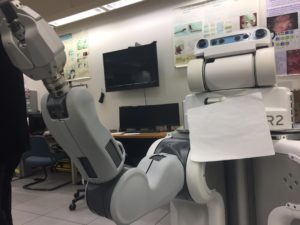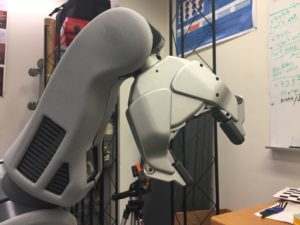
A robot that specializes in grasping objects in Columbia University’s Robotics Group lab. Photo: Sanam Yar.
Phil Jacobsen, 53, never thought he’d be able to feed himself again. Four years ago, doctors diagnosed him with the neurodegenerative disorder ALS, which affected his voluntary muscle control and caused his muscles to weaken to the point of needing assistance with tasks like eating. His wife, Sonya Jacobsen, helped feed him meals three times a day.
“For Phil, it started in losing mobility in his arms and hands, initially impacting his eating, bathing, and dressing himself,” said Sonya Jacobsen in a phone interview from her home in Bryn Mawr, Pennsylvania.
Then came the robot. On Christmas morning in 2016, the Jacobsens opened a gift from their friends and family — an Obi, a sleek, white robot comprised of a four-compartment dish and arm with a spoon attachment. After placing Obi on the table in front of a diner, a caregiver grasps the arm and teaches it the delivery location on first use. Obi requires some level of mobility to initiate the feeding mechanism, so Jacobsen used his foot to press the button that spurred the arm to scoop up foods like rice and stir-fry and carry it to his mouth, so that he could eat with his family.
The Jacobsens used the machine three to five times a week, since the attached spoon couldn’t grip many foods, like spaghetti. But when it did work, “it gave my husband a sense of independence,” said Sonya Jacobsen. “It gave more freedom for both of us, it brought normalcy back to meal time.”
Along with helping the differently-abled of all ages, Obi, and other robots like it, present a technological solution to the looming issue of an aging population. Approximately 98 million people will be 65 or older by 2060, nearly one in four Americans, according to the U.S Census bureau. By 2050, the number of individuals using paid long-term care services in any setting—individual homes, assisted living, and nursing facilities—will double to 27 million people, according to the U.S. Department of Health and Human Services. Overall employment of home health and personal care aides is projected to grow 41 percent from 2016 to 2026, much faster than the average for all occupations, and elder-care experts predict a shortage of human caregivers to meet demand.
That’s where robots come in. “We have solutions and devices for almost every activity of daily living, from walking to eyeglasses, but we don’t have anything to assist arguably the most basic human need, the individual’s ability to eat,” says Jon Dekar, Obi’s creator and CEO and co-founder of Ohio-based robotics company Desin. “People figure out how to use it to a level where it becomes second nature quite quickly, allowing users to focus on the more experiential aspect of dining.”
People often picture the future of assistive robotics as “robot butlers that kind of do everything, which is not realistic even within the next 20 years,” says Dr. Cynthia Matuszek, assistant professor of computer science and electrical engineering at University of Maryland, Baltimore County. “What we’re likely to see much sooner is highly specialized robots performing singular tasks, like the Roomba and Obi.”

The claw and arm mechanism of a robot designed to pick up and hold objects in Columbia University’s Robotics Group. Photo: Sanam Yar.
While Obi is available for purchase through the company’s website, many robots that assist with eating are still in early stages. Research studies have tested robots that help the elderly manage their medications as well as social motivator robots that encourage people to eat through meal-related cues and encouragement. A robot named Pearl was developed for assisted living facilities, routinely reminding residents to drink and eat.
Matuszek says that right now the most advanced robots remind people of tasks, as anything with a physical interaction component has to be rigorously tested for safety. She estimates that broad consumer-grade assistive care robots like Obi will be more commonplace in the next five to ten years.
Currently, the available robots come at a cost. Obi runs about $6000 per machine. The Japanese company Secom Co.’s My Spoon Eating robot, a swivelling arm fitted with a spoon and fork that picks food up from a tray and directs it towards the mouth, costs $3500. The robotic arm is controlled with a joystick that requires minimal intervention from a caregiver. Care-O-bot, developed by German company Fraunhofer IPA, is meant as more of a commercial service robot rather than a product for individuals, and it runs upwards of $100,000. So far, it’s been deployed in a number of German assisted living facilities, carrying and delivering food and drinks from the kitchen to residents.
Dekar says that while the cost is high, robots like Obi enhance the productivity of caregivers. “A caregiver that would ordinarily have to spoon feed a resident for a half hour at a time can now simply set up the device,” says Dekar. “It basically eliminates 80 percent of the time they would spend and they can supervise multiple people eating with a machine at the same time.”
Heritage Downtown, a retirement community in Walnut Creek, California, uses robots in pilot programs to try to improve the quality of life of its residents, but has yet to use any food-related robots.
“As AI advances, we’re definitely interested in this kind of thing for the future,” said spokesperson Jenny Shively over a phone interview, “whether that’s a little robot carrying a tray of dinner to a senior who just had knee replacement surgery or a robot helping in the kitchen.”
Still, these machines have a long way to go before they become viable on a mass-market level. After six months of use, Phil Jacobsen’s degenerative condition caused him to lose motor control of his foot, making it too difficult to independently operate the Obi. The Jacobsens donated the machine to the ALS Association and are back to manual feeding, but they remain hopeful of finding devices that can help in the future.
“It didn’t work for us in the long term, but more devices to help others in this realm are always a good thing,” says Sonya Jacobsen. “Down the road when they’re perfected more, these robots could really be great.”
Tags: elder care, home care, meal assistance, robots, technology

Your Comments